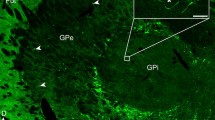Summary
The nucleus tegmentalis dorsalis (NTD) which may be homologous with the mammalian locus coeruleus was investigated in the chicken by means of light, fluorescence and electron microscopy.
Results are summarized as follows: 1) Numerous neurons emitting green fluorescence by the Falck-Hillarp method were observed in the NTD of the chicken. By consecutive light and fluorescence microscopy of the same section it was established that these catecholamine(CA)-containing neurons clearly coincided with the cell group named nucleus tegmentalis dorsalis by Jungherr (1945). This procedure further showed that there were also non-fluorescent neurons in the NTD. 2) On the basis of electron microscopic observation, two types of neurons were recognized in the NTD: medium-(15–25 μm) and small-sized (10–15 μm) neurons. Medium-sized neurons had a round to oval nucleus with several deep infoldings and abundant organelles. From combined fluorescence and electron microscopic examination, they obviously corresponded with CA-containing neurons demonstrated by the Falck-Hillarp method. Small-sized neurons had a round nucleus surrounded by pale cytoplasm. They corresponded with non-CA-containing neurons. 3) From morphometric analysis, it was clear that CA-containing neurons contained a well-developed rough-surfaced endoplasmic reticulum and many lysosome-like dense bodies, unlike non-CA-containing neurons.
This study was undertaken as the basis of a research program to elucidate the catecholaminergic projections from the NTD.
Similar content being viewed by others
References
Baumgarten HG, Braak H (1968) Catecholamine im Gehirn der Eidechse (Lacerta viridis und Lacerta muralis). Z Zellforsch 86:574–602
Björklund A, Falck B, Ljunggren L (1968) Monoamines in the bird median eminence: Failure of cocain to block the accumulation of exogenous amines. Z Zellforsch 89:193–200
Dahlström A, Fuxe K (1964) Evidence for the existence of monoamine-containing neurons in the central nervous system. I. Demonstration of monoamines in the cell bodies of brain stem neurons. Acta Physiol Scand 62: Suppl 232, 1–55
Dubé L, Parent A (1981) The monoamine-containing neurons in avian brain: I. A study of the brain stem of the chicken (Gallus domesticus) by means of fluorescence and acetylcholinesterase histochemistry. J Comp Neurol 196:695–708
Eden AR, Correia MJ (1981) Vestibular efferent neurons and catecholamine cell groups in the reticular formation of the pigeon. Neurosci Lett 25:239–242
Falck B (1962) Observations on the possibilities of the cellular localization of monoamines by a fluorescence method. Acta Physiol Scand 56: Suppl 197, 1–26
Falck B, Hillarp N-Å, Thieme G, Torp A (1962) Fluorescence of catecholamines and related compounds condensed with formaldehyde. J Histochem Cytochem 10:348–354
Fuxe K, Ljunggren L (1965) Cellular localization of monoamines in the upper brain stem of the pigeon. J Comp Neurol 125:355–382
Fuxe K, Hökfelt T, Nilsson O, Reinius S (1966) A fluorescence and electron microscopic study on central monoamine nerve cells. Anat Rec 155:33–40
Honma S, Honma Y (1970) Histochemical demonstration of monoamines in the hypothalamus of the lampreys and ice-goby. Bull Jpn Soc Sci Fish 36:125–134
Hubbard JE, Carlo VD (1973) Fluorescence histochemistry of monoamine-containing cell bodies in the brain stem of the squirrel monkey (Saimiri sciureus). I. The locus caeruleus. J Comp Neurol 147:553–566
Ikeda H, Gotoh J (1971) Distribution of monoamine-containing cells in the central nervous system of the chicken. Jap J Pharmacol 21:763–784
Ishikawa M, Shimada S, Kataoka C (1975) Histochemical mapping of catecholamine neurons and fiber pathways in the pontine tegmentum of the dog. Brain Res 86:1–16
Jungherr E (1945) Certain nuclear groups of the avian mesencephalon. J Comp Neurol 82:55–76
Kataoka K, Shimizu K, Yamamoto T, Ochi J (1979) Monoamine-containing cells in the gastric mucosa of the kitten: A new method employing comparative fluorescence and electron microscopy on identical cells. Acta Histochem Cytochem 12:383–390
Léger L, Hernandez-Nicaise M-L (1980) The cat locus coeruleus: Light and electron microscopic study of the neuronal somata. Anat Embryol 159:181–198
Lenn NJ (1965) Electron microscopic observations on monoamine-containing brain stem neurons in normal and drug-treated rats. Anat Rec 153:399–406
Mizuno N, Nakamura Y (1972) An electron microscope study of the locus coeruleus in the rabbit, with special reference to direct hypothalamic and mesencephalic projection. Arch Histol Jpn 34:433–448
Muhibullah M, Stephenson JD (1975) Distribution of catecholamines and 5-hydroxytryptamine in the chicken brain (Gallus domesticus). J Physiol 246:27p-28p
Nyström B, Olson L, Ungerstedt U (1972) Noradrenaline nerve terminals in human cerebral cortices: First histochemical evidence. Science 176:924–926
Ramon-Moliner E (1974) The locus coeruleus of the cat. III. Light and electron microscopic studies. Cell Tissue Res 149:205–221
Sato T (1968) A modified method for lead staining of thin sections. J Electron Microsc 17:158–159
Sharp PJ, Follett BK (1968) The distribution of monoamines in the hypothalamus of the Japanese quail, Coturnix coturnix japonica. Z Zellforsch 90:245–262
Shimizu N, Imamoto K (1970) Fine structure of the locus coeruleus in the rat. Arch Histol Jpn 31:229–246
Shimizu N, Ohnishi S, Satoh K, Tohyama M (1978) Cellular organization of locus coeruleus in the rat as studied by Golgi method. Arch Histol Jpn 41:103–112
Tohyama M, Maeda T, Hashimoto J, Shrestha GR, Tamura O, Shimizu N (1974) Comparative anatomy of the locus coeruleus. I. Organization and ascending projections of the catecholamine-containing neurons in the pontine region of the bird, Melopsittacus undulatus. J Hirnforsch 15:319–330
Weibel ER (1969) Stereological principles for morphometry in electron microscopic cytology. Int Rev Cytol 26:235–302
Author information
Authors and Affiliations
Rights and permissions
About this article
Cite this article
Chikazawa, H., Fujioka, T. & Watanabe, T. Catecholamine-containing neurons in the mesencephalic tegmentum of the chicken. Anat Embryol 164, 303–313 (1982). https://doi.org/10.1007/BF00315753
Accepted:
Issue Date:
DOI: https://doi.org/10.1007/BF00315753




